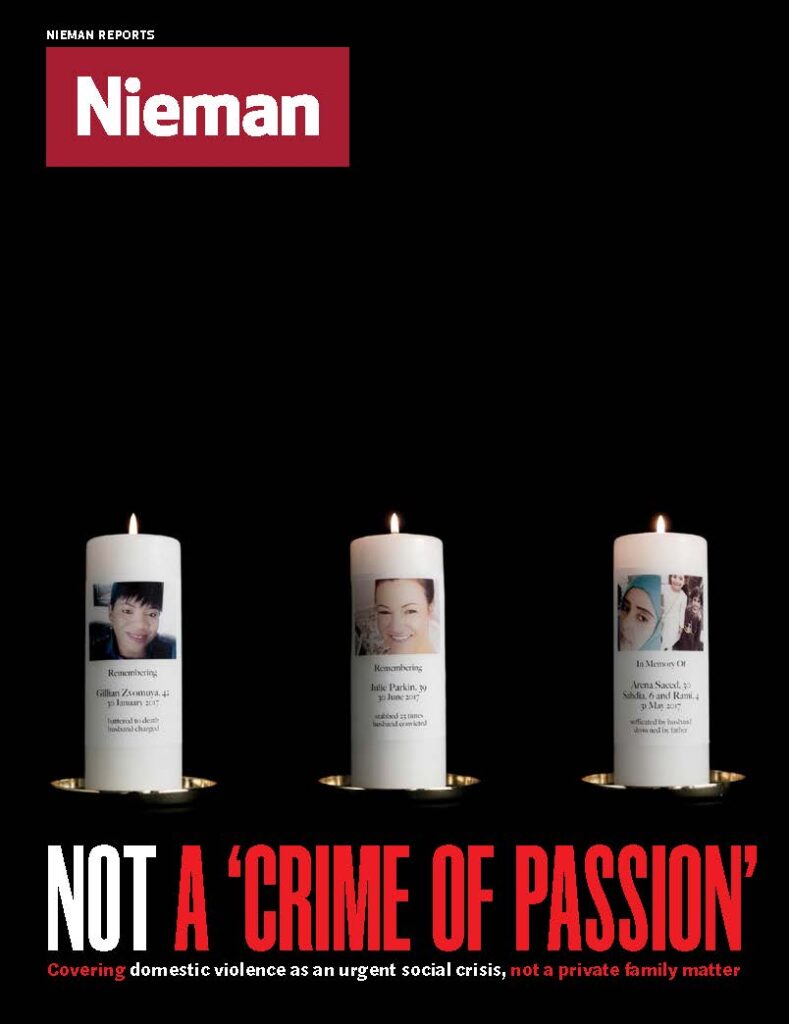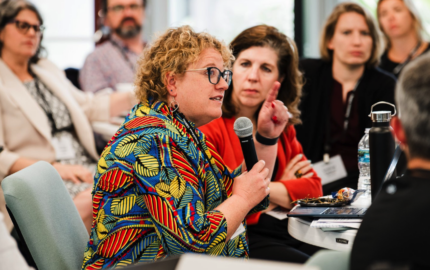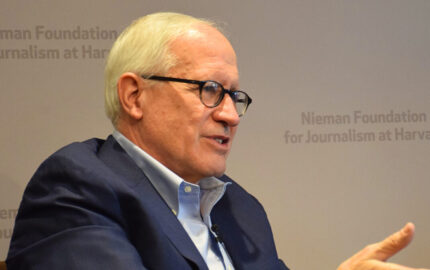After nearly a decade as co-editors, in 2015, Bauerlein became CEO of Mother Jones while Jeffery took over as editor-in-chief. Both have worked at the publication for close to 20 years—Bauerlein joined as an investigative editor in 2000, and Jeffery started as a deputy editor in 2002. Jeffery worked at the Washington City Paper and was senior editor at Harper’s. Bauerlein has been a correspondent for the Associated Press and managing editor of the Minneapolis-based alternative weekly City Pages.
Bauerlein and Jeffery visited the Nieman Foundation to accept the I.F. Stone Medal for Journalistic Independence in May, and during the presentation, discussed Mother Jones’ success, covering the 2020 presidential election, and more. Edited excerpts:
On the success of Mother Jones under their leadership
Clara Jeffery: When we took the helm, there was a lot of talk of a leadership vacuum, that we’d be in catfights, that we’d pull each other’s hair, that we were job‑sharing when that was never true, unless you can share a 19‑hour day that each of us had many times.
Thanks to the amazing team at Mother Jones and the faith that our board and others put in us, we’ve grown exponentially. Our organization has three times the budget now. It has 10 times as many people in the newsroom, 15 times the audience. We now reach about eight million people a month and we’re fortunate enough to employ about a hundred of the best journalists in the country.
Monika Bauerlein: It is an arc that we’re not seeing enough of in news at the moment. It’s an incredibly tough time for our profession, but journalism has tools to defend itself.
Maybe the most important tools are these values that we come from and that we have seen—that when you can communicate to audiences that you stand with them, that your alliance or your allegiance is not to a hedge fund or a billionaire—even a nice one— but that you are there for the public interest, wherever that may take you, that people do respond to that.
Public trust is actually rebounding. People are engaging with journalism in ways that they haven’t for a long time. It shows us a path where the people who can save the journalism that the public needs is the public.
On what it means to be an independent news organization
Jeffery: There are many forces that you need to be independent of. One is to sometimes challenge the folks who are more inclined to your publication. We’ve done that a lot in the past few years. I think that that is something that is more and more fraught, at least online, sometimes to do.
It’s also having the financial and structural independence from just one or two really rich people. It’s re-engaging the audience, making them feel that they are a part of us. That’s in order to get them to share and spread your work, but it also has this ancillary benefit of many of them financially supporting your work.
They believe in what you do. They want to see more of what you do. Whether it’s on a particular area of coverage or the whole shebang, they’ve risen to the fore and help support and grow us.
On not catering to the audience’s preconceptions
Bauerlein: As journalists, we were trained to believe—[that if you seek member support, you are under pressure to serve their preconceptions and beliefs]. That’s why it took so long for newsrooms to orient themselves toward the audience because we assume that if you do that, then you’ll be catering to the lowest common denominator and you will not be making these august decisions about what’s important and what people should hear about.
That’s a sad statement about our relationship with the people on whom we depend and for whom we do this work. Have more faith and trust in the public to be able to digest challenging information and to actually be looking for that. We get a lot of feedback from our audience saying, “I didn’t like this or that or the other thing that you wrote, but I’m glad that you did.”
In 2016 during the campaign, we did a lot of work on the right and conservatism and how conservative thought was being pulled over into white supremacist territory. That was difficult, especially when it involved understanding why people might be thinking these things. Being empathetic and taking them seriously and interrogating them about where they were coming from while still holding on to a core notion that white supremacy and racism are not OK, but that we need to see why they got traction at moment. That was something people struggled with quite a bit.
Jeffery: I think that it’s true always, but more true recently, that you’ve got to plow ahead and try and tell the story as best you understand it, realizing that there are going to be people who legitimately disagree with you or attack what you’re doing to signal something to their tribe.
There’s more of that going on now than used to be visible. It can be a negative force in public discourse, but by steering the ship as best you can and acknowledging these factors even in your own reporting you can win people over.
On making the value proposition of giving journalism away for free but asking people to support it
Jeffery: David Carr was an old boss of mine. When he was at The New York Times before he died tragically, we used to get into somewhat of an argument. I was like, “Why doesn’t the Times start a nonprofit piece so that people could give it money without having to get the dead tree shipped to them?” He was like, “We can’t do that because of our advertisers.” We were already down this road. So it was interesting to watch the Times after [the election of] Trump essentially make that proposition. They’ve gone to a model that allows people to support them whether or not they read them in paper form because they know that people want to support the journalism.
We all wish it were more people, but when we make that clear to readers, they do respond. They know that journalism is needed now more than ever. Whether it’s their local paper or national papers or any kind of media that they care about, many of them, when it’s put to them in that way, will step up.
On the business models of the future
Jeffery: It’s not going to be advertising. It’s going to be subscriptions, or donor support, or nice billionaires or a combination of the above. I think advertising is going the way of when Napster disrupted the music industry. Nonprofits and things that had to be scrappier realized this earlier just because we didn’t get the lush six‑page Versace ads.
If we could go back in time, certainly in the news business, we would have taught our audience better why their paper was so cheap. Why you could get The New Yorker for $12 a year, whatever the price used to be. It is not the price to produce the stuff that’s being made.
If advertising cannot subsidize it, and in this country, government is unlikely—and probably at least for the moment, that’s a good thing—to help, then who’s going to do it? It has to be the public in one form or fashion.
On being transparent with audiences about the cost of producing journalism
Bauerlein: It’s a big bet born of a deep assessment of the factors involved, but also the fact that when you’re a journalist, you have a hammer. Every problem is a nail and your hammer is explaining things in a story.
It occurred to us that, as journalists, we were having a relationship of depth and explanation with the content, but not on the fundraising and marketing side. Might it make sense to have that same high‑level conversation with our audience when it came to how the organization runs and the role that they play?
Jeffery: In a way, the church and state between the business side was thought to be this great thing, but I think what it did was make both sides ignorant of the problem at hand. One side held the insight, maybe not good enough at the time, about the audience, and the others really knew the books, but there was not much communication between them. That was seen as corrupt somehow.
Whatever corruption there was was there in the ad pages and in some of the other concessions publishers would make, but it wasn’t in terms of figuring out how are we going to pay for what we want to do and what’s most important for us to pay for.
On how the Mother Jones model can be replicated at local news outlets
Bauerlein: Obviously, every community is different, every organization is different. What has worked for Mother Jones is uncompromising journalism that meets a need that the audience has. A diversity of revenue streams: We have advertising. We have subscriptions. We have reader support in the form of donations with many zeroes or none. Anything else that comes around that is ethical that we can turn into revenue, we will do. Any one of them can be weak at any given time and that’s painful. It’s painful when you look at digital advertising right now, but it’s not catastrophic.
Another piece is turning a transactional relationship into a true relationship, into a relationship of support and having a broad base of people who are willing to engage with the work. If we see ourselves as part of a democracy, then we also need to be democratically organized.
That’s a conversation that’s just beginning, [figuring out how to help spread this to smaller local news organizations]. We both come from local journalism. Seeing what has happened, we both cut our teeth at alternative weeklies, and you know what has happened to them. Finding a way to share what we’ve learned with people solving this problem at the local level is a very live conversation.
On the importance of following up on investigative reports
Jeffery: I won’t say that we at all do a perfect job of it, but that precise reason [of wanting to follow up on investigative reporting years later] is why we went to our board in the Mother Jones 2.0 initiative [when Monika and I took over] and said, we can’t do investigative reporting with the model that we had at the time, which was mostly freelance investigative reporters and editors at Mother Jones.
We need to go down rabbit holes we know might not be productive. We need to be able to follow up. We need staff writers in a more newspaper‑like staff structure. That has paid off enormously in being able to follow up.
Another thing that we’ve done is dedicate reporters to beats that might be a little bit more unusual. For example, Julia Lurie has had a beat [looking at the opioid crisis from a different angle]. After the 2016 election, I was looking at a map of where Trump won and didn’t win. I had looked at a map of the worst parts of the opioid crisis, and I was like, “There’s something here.” We’ll do a lot on the opioid crisis, but we’re going to get into who’s making money on it, and how this is affecting the political landscape.
Having staff writers and being able to dedicate someone for a few years to, in some ways, an esoteric kind of beat, has been great. That’s when we’ve done our best work, frankly.
On overcorrecting for accusations of bias
Bauerlein: When you yell at the press long enough and hard enough about the truth being an exercise in bias, people start to overcorrect for it and bend over backward to appease the people who are often doing the yelling in bad faith.
There are people who in good faith have criticisms of the press. We need to engage with that and listen to it and be made uncomfortable by it. But there are also people who are pursuing an agenda of making us less bold in pursuit of the truth. We don’t have that much time to get this right.
On covering the 2020 election and not repeating the same mistakes
Bauerlein: The question is have we learned enough from what happened in 2016 in terms of better covering a changed political landscape? It would be a huge stretch to say that we’ve learned the lessons, as a profession. All of us made mistakes. All of us missed part of the story.
Some improvements have been made, but there also is a degree of defensiveness and allegiance to the way that we have historically done things that is particularly powerful in the context of a presidential campaign where muscle memory kicks in and it’s very, very difficult for any of us to confront just how flawed the traditions and habits of the profession are.
Jeffery: There were a lot of mistakes made and stories not told or not amplified well enough. One of the greatest problems we have throughout the industry, but particularly amongst the biggest, heaviest hitters, is that there’s not a willingness to own up to what happened and report out what happened.
Eventually we’ll learn, but if journalism was more honest about when it screws up and why, our democracy will be better off.
If we could do one thing, it would be bring back the ombudsmen and do more media reporting that was about that and really probative and thoughtful and not just “got you” or who got fired. That is one thing I would like to see our profession invest more time and money in.




